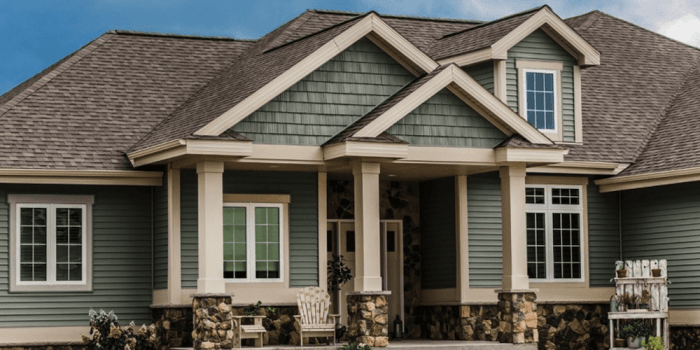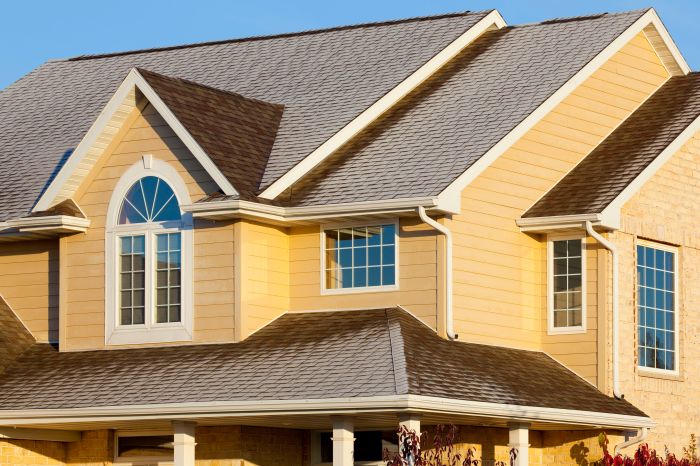The Best Siding for Homes: A Comprehensive Guide

When it comes to choosing the best siding for homes, the options can be overwhelming. From classic vinyl to durable fiber cement, each material has its own unique advantages and drawbacks. Let's delve into the world of siding materials and uncover the best choices for your home.
In this guide, we will explore the different types of siding materials, factors to consider when making a selection, the role of energy efficiency and insulation, maintenance tips for longevity, and the impact of aesthetics on curb appeal.
Types of Siding Materials
When it comes to choosing siding for your home, there are several materials to consider. Each type of siding material has its own unique characteristics, benefits, and drawbacks. Let's take a closer look at some of the most popular siding options available:
Vinyl Siding
Vinyl siding is a common choice for many homeowners due to its affordability and low maintenance requirements. It comes in a variety of colors and styles, making it a versatile option for different home designs. However, vinyl siding may not be as durable as other materials and can crack or fade over time.
Wood Siding
Wood siding offers a natural and timeless look that can enhance the overall aesthetic of a home. It is also relatively easy to repair and replace damaged sections. On the downside, wood siding requires regular maintenance, such as painting or staining, to prevent rot and decay.
Fiber Cement Siding
Fiber cement siding is a durable and long-lasting option that can mimic the look of wood or masonry. It is resistant to rot, fire, and pests, making it a popular choice for many homeowners. However, fiber cement siding can be heavier and more difficult to install compared to other materials.
Metal Siding
Metal siding, such as aluminum or steel, is known for its strength and durability. It is resistant to fire, insects, and rot, making it a low-maintenance option for homes. However, metal siding can dent or scratch easily and may be more costly upfront compared to other materials.
Factors to Consider
When choosing siding for your home, there are several important factors to consider to ensure you make the right choice. Factors such as climate, architectural style, and personal preferences play a significant role in determining the most suitable siding material.
Impact of Climate
The climate of the region where your home is located should heavily influence your choice of siding material. For example, in areas with high humidity or frequent rainfall, materials like vinyl or fiber cement siding are more resistant to moisture damage.
On the other hand, in regions with extreme temperature variations, such as hot summers and cold winters, materials like wood or engineered wood siding may be more suitable due to their insulation properties.
Architectural Style and Personal Preferences
The architectural style of your home can also guide your decision when selecting siding. For traditional or historic homes, materials like wood or brick may be more appropriate to maintain the authenticity and charm of the property. Modern homes, on the other hand, may benefit from sleek and durable options like metal or stucco siding.
Additionally, personal preferences such as color, texture, and maintenance requirements should also be taken into account to ensure you are satisfied with the overall look and feel of your home.
Energy Efficiency and Insulation
The role of siding in improving energy efficiency in homes cannot be overstated. Siding acts as a protective barrier against the elements, helping to maintain a consistent indoor temperature and reduce the workload on heating and cooling systems. This, in turn, leads to lower energy consumption and utility bills.
Contribution of Different Siding Materials to Insulation
- Vinyl Siding: Vinyl siding is known for its insulation properties as it helps to reduce heat loss during colder months and heat gain during warmer months. It can be further enhanced with added insulation layers.
- Fiber Cement Siding: Fiber cement siding offers excellent thermal performance and helps to regulate indoor temperatures effectively.
- Wood Siding: Wood siding provides natural insulation and can help keep homes warm in winter and cool in summer.
- Insulated Siding: Specifically designed for enhanced insulation, insulated siding features added foam insulation to improve energy efficiency significantly.
Examples of Siding Options with Best Thermal Performance
- James Hardie Fiber Cement Siding: Known for its durability and excellent insulation properties, James Hardie siding is a popular choice for energy-efficient homes.
- LP SmartSide Engineered Wood Siding: This siding option offers great thermal performance and can help reduce energy costs over time.
- Alside Prodigy Insulated Siding: With built-in insulation, Alside Prodigy siding provides superior energy efficiency and thermal performance.
Maintenance and Longevity

Maintaining your home's siding is crucial for its longevity and overall appearance. Different siding materials require varying levels of maintenance to ensure they last as long as possible. Here, we will discuss the maintenance requirements, lifespan, and tips to extend the longevity of different siding options.
Maintenance Requirements
- Vinyl Siding: Vinyl siding is relatively low maintenance and only requires occasional cleaning with soap and water to remove dirt and grime.
- Fiber Cement Siding: Fiber cement siding needs to be repainted every 10-15 years to maintain its appearance and protect it from the elements.
- Wood Siding: Wood siding requires regular painting or staining every 3-7 years, as well as inspections for rot or pest damage.
- Aluminum Siding: Aluminum siding should be washed annually to prevent oxidation and rust formation.
- Brick Siding: Brick siding is very durable and only needs occasional cleaning to remove dirt and moss buildup.
Lifespan of Different Siding Options
- Vinyl Siding: 20-40 years
- Fiber Cement Siding: 50+ years
- Wood Siding: 20-40 years
- Aluminum Siding: 20-40 years
- Brick Siding: 100+ years
Tips to Extend Longevity
- Regularly inspect the siding for any damage, such as cracks, rot, or pest infestations, and address them promptly.
- Keep the siding clean by washing it with a mild detergent and water to prevent mold and mildew growth.
- Trim any vegetation near the siding to prevent moisture buildup and potential damage.
- Ensure proper installation to prevent water infiltration and prolong the lifespan of the siding.
Aesthetics and Curb Appeal

When it comes to enhancing the overall look of a home, the choice of siding plays a crucial role in boosting curb appeal. The right siding can not only improve the aesthetic appeal of a house but also increase its value.
Let's delve into how siding materials can transform the appearance of a home.
Color Options, Textures, and Design Choices
Selecting the perfect color, texture, and design for your siding can significantly impact the curb appeal of your home. Different siding materials offer a wide range of options to choose from, allowing homeowners to personalize the look of their property.
Whether you prefer a classic, traditional style or a more modern and sleek design, there is a siding material to suit your preferences.
- Color Options: From earthy tones to bold hues, siding materials come in a variety of colors to match your taste and the architectural style of your home. Consider colors that complement the existing elements of your house, such as the roof, trim, and landscape.
- Textures: Siding materials like wood, vinyl, and fiber cement offer different textures that can add depth and visual interest to the exterior of your home. Textured siding can create a rustic, cozy feel or a sleek, contemporary look, depending on your desired aesthetic.
- Design Choices: Whether you prefer horizontal lap siding, vertical panels, shingles, or another design, each option can contribute to the overall curb appeal of your home. The design of the siding can highlight architectural features or create a unique focal point on the exterior.
Selecting Complementary Siding
When choosing siding for your home, it's essential to consider how it will complement the overall look of the property. Harmonizing the siding with other exterior elements like windows, doors, and landscaping can create a cohesive and visually appealing appearance.
Here are some tips for selecting siding that enhances the curb appeal of your home:
- Consider the architectural style of your home and choose siding that aligns with its design elements.
- Take into account the surrounding environment and neighborhood aesthetics to ensure your siding blends in seamlessly.
- Use color samples and visualize how different siding options will look on your home before making a final decision.
- Consult with a design professional or contractor to get expert advice on selecting siding that enhances your home's curb appeal.
Final Review
As we conclude our exploration of the best siding for homes, it's clear that the right choice can make a significant difference in the overall look, feel, and efficiency of your home. By understanding the various options available and considering key factors, you can select siding that not only enhances your home's appearance but also provides lasting value and protection.
FAQ
What is the most durable siding material?
Fiber cement is known for its exceptional durability and resistance to harsh weather conditions, making it a popular choice for homeowners looking for long-lasting siding.
How does climate affect the choice of siding material?
Climate plays a crucial role in determining the best siding material for a home. For example, in areas with high humidity, materials like vinyl or fiber cement may be more suitable due to their resistance to moisture.
What are some low-maintenance siding options?
Vinyl siding is often preferred for its low maintenance requirements, as it only needs occasional cleaning to maintain its appearance.
Can siding improve energy efficiency in homes?
Yes, certain types of siding materials like insulated vinyl or fiber cement can contribute to better energy efficiency by providing additional insulation to the home.
How can I choose siding that enhances my home's curb appeal?
Consider factors like color, texture, and design options to select siding that complements your home's architectural style and overall aesthetic.

